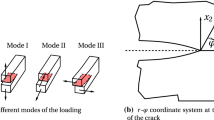Abstract
We consider the probability of failure for components made of brittle materials under one time application of a load, as introduced by Weibull and Batdorf-Crosse. These models have been applied to the design of ceramic heat shields of space shuttles and to ceramic components of the combustion chamber in gas turbines, for example. In this paper, we introduce the probability of failure as an objective functional in shape optimization. We study the convexity and the lower semi-continuity properties of such objective functionals and prove the existence of optimal shapes in the class of shapes with a uniform cone property. We also shortly comment on shape derivatives and optimality conditions.


Similar content being viewed by others
Notes
We note that in [6] a different set of conditions is referred to as Neumann boundary conditions, hence the term natural boundary conditions in order to avoid confusion.
References
Weibull, E.W.: A statistical theory of the strength of materials. Ingeniors Vetenskaps Akad. Handl. 151, 1–45 (1939)
Allaire, G.: Numerical Analysis and Optimization. Oxford University Press, Oxford (2007)
Delfour, M.C., Zolesio, J.P.: Shapes and Geometries. Advances in Design and Control, 2nd edn. SIAM, Philadelphia (2011)
Eppler, K.: Efficient Shape Optimization Algorithms for Elliptic Boundary Value Problems. Habilitationsschrift Technische Universität Chemnitz, Chemnitz (1997)
Haslinger, J., Mäkinen, R.A.E.: Introduction to Shape Optimization—Theory, Approximation and Computation. SIAM, Philadelphia (2003)
Sokolowski, J., Zolesio, J.P.: Introduction to Shape Optimization—Shape Sensitivity Analysis. Springer, Berlin (1992)
Batdorf, S.B., Crosse, J.G.: A statistical theory for the fracture of brittle structures subject to nonuniform polyaxial stress. J. Appl. Mech. 41, 459–465 (1974)
Heger, A.: Bewertung der Zuverlässigkeit mehrachsig belasteter keramischer Bauteile. No. 132 in Fortschrittberichte VDI/18. VDI-Verlag, Düsseldorf (1993)
Nemeth, N.N., Manderscheid, J., Gyekenyeshi, J.: Ceramic analysis and reliability evaluation of structures (cares). Report TP-2916, NASA (1990)
Riesch-Oppermann, H., Brückner-Foit, A., Ziegler, C.: Stau—a general purpose tool for probabilistic reliability assessment of ceramic components under multi axial loading. In: Proceedings of the 13th International Conference on ECF 13, San Sebastian (2000)
Riesch-Oppermann, H., Scherrer-Rudiya, S., Erbacher, T., Kraft, O.: Uncertainty analysis of reliability predictions for brittle fracture. Eng. Fract. Mech. 74, 2933–2942 (2007)
Weil, N.A., Daniel, I.M.: Analysis of fracture probabilities in nonuniformly stressed brittle materials. J. Am. Ceram. Soc. 47, 268–274 (1964)
Ziegler, C.: Bewertung der Zuverlässigkeit keramischer Komponenten bei zeitlich veränderlichen Spannungen unter Hochtemperaturbelastung. No. 238 in Fortschritt-Berichte des VDI, Series 18. VDI-Verlag (1998)
Munz, D., Fett, D.: Mechanische Eigenschaften von Keramik. Springer, Berlin (1989)
Brückner-Foit, A., Hülsmeier, P., Diegele, E., Rettig, U., Hohmann, C.: Simulating the failure behaviour of ceramic components under gas turbine conditions. In: Proceedings of ASME TURBO EXPO 2002 June 3–6, 2002, Amsterdam (2002)
Hülsmeier, P.: Lebensdauervorhersage für keramische Bauteile. Dissertation, Universität Karlsruhe (2004)
Brückner-Foit, A., Fett, T., Munz, D., Schirmer, K.: Discrimination of multiaxiality criteria with the brasilian disk test. J. Eur. Ceram. Soc. 17, 689–696 (1997)
Gambarotta, L., Lagomarsino, S.: A microcrack damage model for brittle materials. Int. J. Solids Struct. 30, 177–198 (1993)
Fuji, N.: Lower semicontinuity in domain optimization problems. J. Optim. Theory Appl. 59, 407–422 (1988)
Ciarlet, P.: Mathematical Elasticity—Volume I: Three-Dimensional Elasticity. Studies in Mathematics and Its Applications, vol. 20. North-Holland, Amsterdam (1988)
Gottschalk, H., Schmitz, S.: Optimal reliability in design for fatigue life. SIAM J. Control Optim. (to appear)
Allaire, G., Bonneter, E., Francfort, G., Jouve, G.: Shape optimization by the homogenization method. Numer. Math. 76, 27–68 (1997)
Chenais, D.: On the existence of a solution in a domain identification problem. J. Math. Anal. Appl. 52, 189–219 (1975)
Evans, A.G.: A general approach for the statistical analysis of multiaxial fracture. J. Am. Ceram. Soc. 61, 302–308 (1978)
Adams, R.A., Fournier, J.J.F.: Sobolev Spaces, 2nd edn. Academic Press, New York (2003)
Gross, D., Seelig, T.: Bruchmechanik, 4th edn. Springer, Berlin (2007)
Kallenberg, O.: Random Measures. Akademie Verlag, Berlin (1975)
Schmitz, S.: A Local and Probabilistic Model for Low Cycle Fatigue—New Aspects of Structural Analysis. Dissertation Thesis, Universitá della Svizzera Italiana, Lugano (2014)
Escobar, L.A., Meeker, W.Q.: Statistical Methods for Reliability Data. Wiley, New York (1998)
Nitsche, J.A.: On Korn’s second inequality. RAIRO Anal. Numer. 15, 237–248 (1981)
Schulz, V.: A Riemannian view on shape optimization. arXiv:1203.1493 (2012)
Udriste, C.: Convex Functions and Optimization Methods on Riemannian Manifolds. Kluwer Academic Publishers, Dordrecht (1994)
Acknowledgments
We would like to thank Patricia Hülsmeier and Christoph Ziegeler for making their Ph.D. Theses available to us. We are grateful to Rolf Krause from ICS Lugano for interesting discussions. We also thank the referees for reading the submitted article very carefully and providing many suggestions for improvement.
Author information
Authors and Affiliations
Corresponding author
Additional information
Communicated by Zenon Mroz.
Rights and permissions
About this article
Cite this article
Bolten, M., Gottschalk, H. & Schmitz, S. Minimal Failure Probability for Ceramic Design Via Shape Control. J Optim Theory Appl 166, 983–1001 (2015). https://doi.org/10.1007/s10957-014-0621-8
Received:
Accepted:
Published:
Issue Date:
DOI: https://doi.org/10.1007/s10957-014-0621-8




